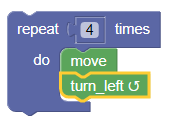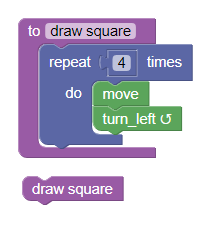Why repeat?
In Reeborg's World, I added a non-standard syntactic construction to Python with an additional keyword: repeat. This allows a student to write
# draw square
repeat 4:
move()
turn_left()
instead of
# draw square
for some_irrelevant_variable in range(4):
move()
turn_left()
Purists will no doubt object to this addition. In this section, I explain my reasoning for this addition.
Three types of loops
When writing programs, there are 3 basic cases for writing a loop:
- repeating some instructions for each item of a "collection";
- repeating some instructions while or until a certain condition is met;
- repeating some instructions a fixed number of times.
Let's consider them in order.
Items in a collection
Here are some examples from Python:
# iterating over a list
for item in [1, 2, 3]:
print(item) # or do something else with the item ...
# iterating over a string:
for letter in "Python":
print(letter)
# iterating over the keys of a dict
for key in {'a': 1, 'b': 2, 'c': 3}:
print(key)
# iterating over a tuple
for item in (1, 2, 3):
print(item)
# iterating over a set:
for element in {1, 2, 3}:
print(element)
# iterating over a file; note that this is not the recommended way
for line in open('test.txt'):
print(line)
The general pattern is
for item in some_iterable:
do_something(item) # this can be an arbitrary code block
It is a powerful pattern which is definitely one of Python's strengths. It also needs to be understood before introducing the very useful list comprehensions and generator expressions in Python.
While or until a condition is met
There are various ways to do this, using a while loop. Here is just one example:
while front_is_clear():
move()
Repeating a fixed number of times
We already have seen an example of repeating a fixed number of times before:
# draw square
for some_irrelevant_variable in range(4):
move()
turn_left()
Python introduces a special built-in iterable, range(), which is then used in the generic for loop construct. For experienced programmers, re-using such a powerful and relatively simple pattern for iterations is great. However, I would argue that it is less than ideal for beginners.
What's wrong with the for loop
Imagine the situation where students have learned two basic instructions: move() and turn_left(). You ask them to use these to draw a square:
move()
turn_left()
move()
turn_left()
move()
turn_left()
move()
turn_left()
You rewrite this to draw their attention to the repeated pattern
move()
turn_left()
move()
turn_left()
move()
turn_left()
move()
turn_left()
And show them that, using repeat they can write this as:
repeat 4:
move()
turn_left()
You use this example to explain the concept of an indented code block the use of a colon, ":", to precede such a code block, and the introduction of one "special" keyword: repeat.
You can show how a pattern like this is "written" using Blockly:1

which gives another representation of what is meant by a code block. The next step might be to teach about defining functions:
def turn_right():
turn_left()
turn_left()
turn_left()
You can point out to them the repeating use of an indented code block preceded by a colon, and the use of a different keyword, def. You might want to again show them a different representation of such a code block.

You can then combine the two concepts:
def draw_square():
repeat 4:
move()
turn_left()
draw_square()
which you can, if desired, also illustrate using Blockly

By contrast, if you decide to just use the standard for loop in Python:
for some_variable in range(4):
move()
turn_left()
you will need to explain (or at least mention):
- the concept of an indented code block preceded by a colon;
- two new keywords,
forandin; - the use of a variable, which is some quantity with a completely irrelevant name in this example, except that it cannot be a keyword.
- the introduction of a built-in function,
range() - that a function can have an argument and the notation for "passing" arguments to a function.
I believe that, until students have seen that functions can have arguments, such as take("token"), and have seen the concept of a variable, it is better to use repeat than the standard Python for loop idiom.2
I should also mention that I have often seen the following awful construct by Python beginners, some of whom were competent programmers in other languages:
for i in range(len(some_list)):
item = some_list[i]
do_something(item)
instead of
for item in some_list:
do_something(item)
I believe that such awful constructs can be avoided if beginners are initially taught to userepeat and that the standard for loop idiom for repeating a fixed number of times is not taught until the students have seen some other examples of for loops. By that time, if they need the loop index, they would likely be ready to learn the proper Python idiom:
for index, item in enumerate(iterable):
do_something(index, item)
Limitation of repeat
By design, what comes after repeat must evaluate as an integer without taking into account the surrounding lines of code.
Thus, the following two constructs are equivalent:
repeat 6:
move()
repeat 2*3: # accidental artefact of the design
move()
However, the following is not valid:
n = 3
repeat n: # n is not known on this line of code
turn_left()
This is a design choice to force the transition to using "normal" Python as soon as students have learned about variables and need to use them to repeat a block of code a fixed number of times, as determined by the value of that variable.
1. I would argue that, even if you do not want your students to use Blockly, it might be useful occasionally and mostly at the beginning, to show them what a small "program" looks like using Blockly - if only to give them a different visual representation of the block-structure of code, like in the examples shown here. ↩
2. When teaching older students in formal courses, like a university-level introduction to programming course, the use of repeat might be limited to only the first and possibly second week of teaching; by the end of the course, it should have been mostly forgotten by the students who would have become familiar with the standard Python idiom. ↩